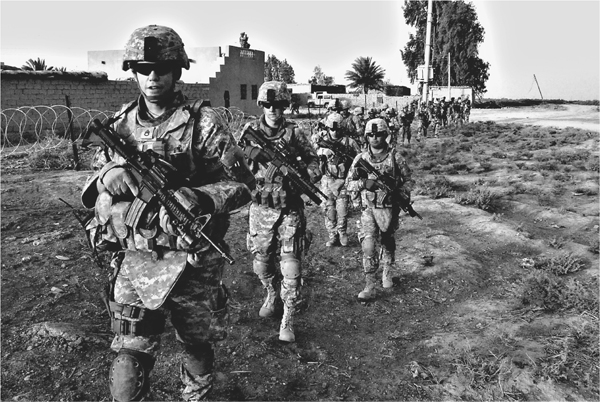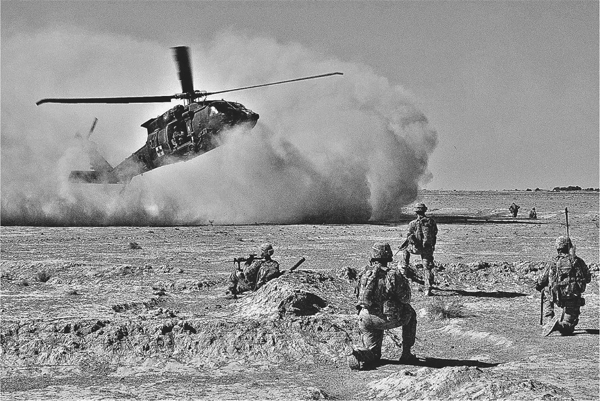Getting Stung in the Hornet’s Nest
My first deployment was to Afghanistan fairly soon after 9/11, and for classified reasons we actually didn’t get called too much. I was a fresh major. We had nine missions over six months, enough to get our feet wet, know we had a tight team, and feel pretty comfortable with our mission. Sure our guys were getting shot, some burned, but nothing much worse than a party weekend in Detroit.
Our second deployment found us in Iraq, just as the hornet’s nest known as Fallujah was getting cleaned up and the Sadr City push was just beginning. Our first mission was five days after our arrival in Iraq. We were sent to move a soldier who had been standing on an improvised explosive device when it exploded. That he was even alive was incredible, of course.
As was the case for so many of our soldiers, the depleted-uranium-reinforced Kevlar body suit saved his torso. As the blast originated from below, the twenty-one-year-old male’s head was relatively uninjured. Both his arms and legs, however, didn’t fare so well—they were gone. It wouldn’t be the last time I saw patients mangled to this extreme, but this was my first one.
You’d be amazed how easy it is to keep just a torso alive. Without arms or legs, there’s no “meat” for the blood to pump through. Exceptionally healthy heart and lungs are not challenged to provide oxygen to just a head and body. Pain is minimal, compared to burns and fractures (no arms and legs means no fractures). There isn’t much for us to fix, just clean and dress the stumps—“all bleeding stops, eventually”—put tubes in lungs, bladder, and stomach, set up the ventilator and add a bit of morphine, and you’re off. Within a few hours of his encounter with the IED, we were ready for the six-to seven-hour flight from Iraq to Germany, where he would receive more extensive surgery at Landstuhl Hospital.

American patrols in Iraq and Afghanistan were vulnerable to improvised explosive devices. Body armor protected their torsos but not their extremities. Advances in trauma care have improved survival rates, but some, with multiple amputations, brain injuries, and severe burns and blindness, wonder if they’d be better off if they hadn’t survived. ARMY PHOTO
The flight to Germany seemed uneventful to my team and our patients. Our other patients had various abdominal or chest injuries that required our presence just in case, but their injuries would mend nicely. Frankly, we had little to do except ensure the ventilators were working and our patients were comfortable.
Not so for the rest of the plane. Flights on the C-17 often had one hundred patients or more, but typically only four to six of those required critical care. The walking wounded sit in chairs along the fuselage, facing inward. There are no curtains or walls—just a brightly lit tube about twenty-four feet in height and diameter.
Everything and everyone is open to observation in the cargo hold. Thus, the remaining space was taken by soldiers with minor injuries (just severe enough to require care in the rear and possibly a return to home stateside). In addition there might be civilians on board who specialist visits, and cargo that needed to get to the United States. Often these minor cases were more than eager to regale pretty nurses with stories of how they earned their war wounds and—given the intensity of combat at that time—any reason to fly out of Iraq to safety in Germany made for good morale.
But on this flight, the mood turned suddenly somber as we arrived with our “torpedo” piled high with bleeping monitors, ventilator, suction machines, and IV pumps. No one could miss the fact that one litter was only half full compared to the others. For six hours, these passengers watched us tend to our multiple-amputee patient. Word got around that we hoped to get this twenty-one-year old soldier home to his newlywed wife and six-month-old daughter. We all wondered what their future would hold. I watched a full-bird colonel break down in silent tears, away from the others on board.
Fast forward to 2012. I’m a colonel-select myself now, six deployments come and gone, and I’m assigned to one of our major military facilities where we receive those very patients from overseas to complete their care. I enjoy 7:00 a.m. to 4:00 p.m. hours teaching young captains and majors to do what I do while tending to the patients in the intensive care units (ICUs).

When a combatant is wounded on the field, it’s imperative to get them medical care as quickly as possible. Medevac helicopters often mean the difference between life and death. ARMY PHOTO
This spring-like morning, I’m walking to the hospital from my car, when I notice a young soldier sporting a flat-top and riding in a motorized wheelchair ahead of me, presumably for a doctor’s appointment. I have no idea why he caught my eye—such sights are common here. Perhaps it was the fact that he was missing both legs. Perhaps, as I overtook him, it was my surprise to see he had two prosthetic arms with which he drove the wheelchair.
Or maybe I unconsciously registered the “jar-head” was shaped a lot like the guy I flew with in 2003. Nope . . . none of that was what made me stop and observe him. What caught my attention was the adorable, blonde-haired, blue-eyed seven-year-old girl, gleefully hugging her daddy and planting kisses on his cheek while he let her ride on his lap. They were laughing together, but I could not hear them.
It was my turn to have silent tears.
—“Dr. Chuck”
War is a messy affair and often, when there’s collateral damage, innocent civilians get added to the body count. During the war in Iraq, thousands of civilians were killed or injured, mostly by sectarian violence, but the American presence there along with other Coalition forces, was a constant, encouraging foreign fighters to converge on Iraq to take on the mighty western “infidels.” Air Force Capt. Scott Brocious, serving as a nurse at the Field Hospital in Balad, Iraq, can’t forget a little girl injured in an explosion.